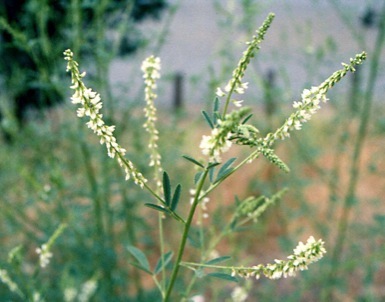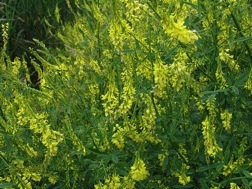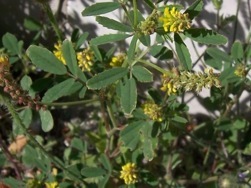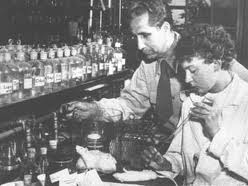
Sweet Clover, M. alba, has a hint of vanilla flavor
Melitotus: Condiment to Tea to Blood Thinner
When I was growing up we owned horses. Lots of horses. And they eat a lot of hay in the winter. Lots of hay. Several tons each (which also has to be shoveled away after… ah… processing.)
So we hayed every summer, loose hay. While most kids had a summer break I went from the classroom to the hay fields for at least 13 summers. School in the fall was a welcomed relief. I remember two things clearly from all those summers in the hay fields: Running over ground hornet nests — they weren’t pleased — and the smell of blood thinner.
Did he say blood thinner? Yep, blood thinner. And many of you have smelled it too, that sweet aroma when you drive by a field of mown hay. What you smelled was coumarin in the making, mostly from the Sweet Clover. It’s the plant’s version of coumadin, Warfarin, rat killer… blood thinner. Actually, the story is more complex and I think an interesting one.
In the early 1900’s the common feed for bovines was Sweet Clover, a native of Europe, introduced in the 1600’s. Over the first 30 years or so of the 20th century farmers would find cows dead in a pool of blood. Frank W. Schofield, upper left, a Canadian veterinarian, had described “Sweet Clover Disease” in 1924 but there was no explanation for it. (By the way, Schofield was no social slouch and was very much involved in the independence movement for Korea.)
In February 1933, Ed Carlson, a farmer from Deer Park, Wisconsin, took one dead heifer, a bucketful of still unclotted blood and 100 pounds of old Sweet Clover to the university looking for answers. It was depression times and Carlson couldn’t afford the loss of a heifer (50% of his stock then) nor even the hay. Karl-Paul Link, right, professor of agriculture with a speciality in chemistry, agreed to research the issue. Link was … different, empathetic, an emotional maverick. I suspect today we would call him bipolar

Melilous officinalis can be white or yellow
A biochemist, Link with the help of PhD students Harold Campbell, Ralph Overman, Charles Huebner, and (later Nobel Prize winner) Mark Stahmann, found coumarin, an anticoagulant, with the Sweet Clover. However, Sweet Clover does not produce courmain. A mold on the clover does. That particular hay year, 1932, was a wet year and the mold very active. Link had discovered what was killing the cattle and steps were taken among cattle owners to reduce their consumption of moldy Sweet Clover. This is why clover should be harvested fresh and mold free, used or immediately dried to prevent molding. (Note to self: Mold also gave us penicillin.)
As fate would have it more than a decade later Professor Link, who had tuberculosis, went on a six month sabbatical to a sanitarium for his health. While there he read about the problem of rodent control and he hit upon the idea of using coumarin to kill rats. He developed and patented in 1947 Warfarin (part of the name comes from Wisconsin Alumni Research Foundation which funded his work. In time he also gave them the patent.)
Technically coumarin does not “thin” the blood. It lengthens the time it takes to clot, that is, it inhibits the production of Vitamin K which is a clotting agent. The antidote for coumarin is Vitamin K. That can be given by a doctor or vet or can also be found in foods such as leafy vegetables, cauliflower, broccoli and some herbal teas.
Link, who was also known as a very eccentric dresser, suffered from his tuberculosis and died in 1978. His little-known role in the discovery of one of the most common anticoagulants, has been called… wait for it… “The Missing Link.” Schofield the vet, born in England in 1889, died in Korea in 1970.
So what of Sweet Clover, Melilotus alba, M. indica, and M. officinalis as forageables?

Melilous indica, of India
The young leaves can be eaten raw, preferably before the plant blossoms. They are bitter and aromatic, usually used as flavoring in salads. The whole plant thoroughly dried can be used to make a tea with a hint of vanilla. The seeds can be used as a spice. Fermented or moldy clover should never be used. Lastly excess consumption can make you throw up. Use carefully and sparingly. Some people report getting a headache when they smell the plant.
Melilotus means honey lotus, from two Greek words, the later the name of a Greek plant possibly clover, or meaning fragrant like the lotus. Alba means white and indica of India. Officinalis does mean official. But in ancient Rome that meant it was sold in a medicinal shop approved by the state. So it means medicinal. The Sweet Clover is also called Sertula in Greek, which is now a separate genus.
Some botanists think M. alba and M. officinalis are the same species, just a white version and a yellow version.
Green Deane’s “Itemized” Plant Profile
IDENTIFICATION: Two to five feet tall, floppy flowers 1/8 inch long, white or yellow, annual or biennial, branching occasionally, often lanky. Light green stems are round or furrowed on all sides) smooth. Leaves alternate, trifoliate, sparsely distributed along the stems, petioles up to one inch long. Grayish leaflets to one one inch long and a third across. Hairless, toothy along the upper margins, and oblong or oblong-ovate, small narrow stipules at the base of each trifoliate leaf’s petiole. The middle leaflet has longest petiole, side leaflets nearly sessile.
TIME OF YEAR: Flowers in March in Florida, June to September in northern climes
ENVIRONMENT: Roadsides, waste places, vacant lots, lightly wooded areas, weed meadows.
METHOD OF PREPARATION: Leaves raw in moderation, used for flavoring in salads, seeds used as a spice, usually the plant is dried and used for tea.



